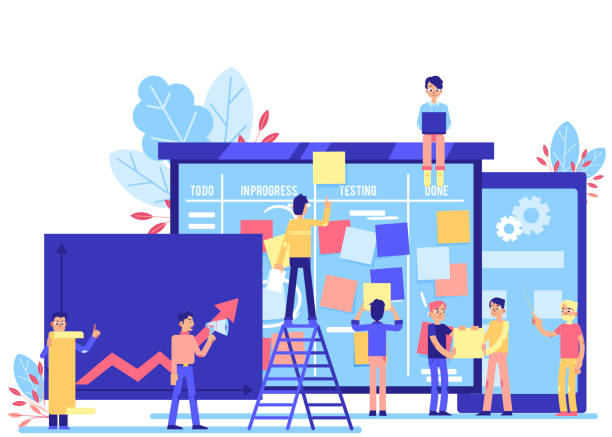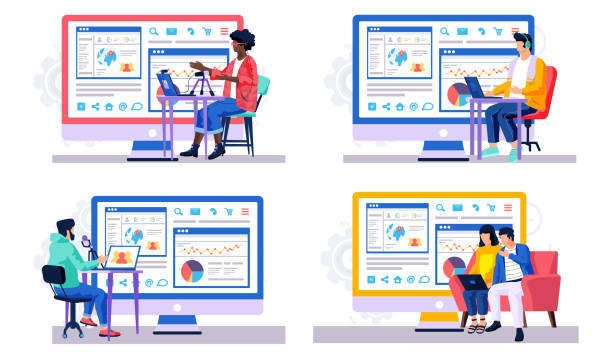Introduction to Fast Website Design and Its Importance

In today’s fast-paced world, #websitespeed is not just a competitive advantage, but has become an absolute necessity.
Internet users have high expectations for page load times, and even a few seconds of delay can mean losing potential visitors and customers.
Fast website design is the key to providing an unparalleled #userexperience and a significant improvement in #SEO rankings.
Studies have shown that even a one-second increase in page load time can significantly increase bounce rates and decrease conversion rates.
This issue is particularly critical in e-commerce, where every millisecond counts.
The importance of fast website design is not limited to user experience; search engines like Google also consider website speed as a crucial ranking factor.
Websites that load faster have a higher chance of achieving top positions in search results.
This is a positive cycle: a faster website keeps users more satisfied, increases engagement, and ultimately helps improve SEO.
In this tutorial, we will thoroughly examine solutions that help you design and optimize your website for maximum speed.
From choosing the right infrastructure to advanced optimization techniques, everything you need for a super-fast website is provided here.
This is an expert guide for anyone looking to improve their website’s performance.
Do you dream of a thriving online store but don’t know where to start?
RasaWeb is your comprehensive e-commerce website design solution.
✅ Attractive and user-friendly design
✅ Increased sales and revenue⚡ Get free consultation
Key Factors Affecting Website Speed

To achieve fast website design, we must first identify the main factors affecting page load speed.
These factors include a set of technical and content elements, each of which can significantly impact your website’s overall performance.
The first and perhaps most important factor is the quality of your hosting and server.
Choosing a reputable hosting provider with powerful servers and sufficient bandwidth is the foundation of a high-speed website.
If your server is slow, all subsequent optimization efforts will be ineffective.
Another factor is content size and optimization.
Large images, videos, and other multimedia files can significantly increase load times.
Compressing images without noticeable quality loss and using appropriate formats for videos are highly important.
Additionally, website coding plays a vital role.
Heavy, messy, or unoptimized CSS, JavaScript, and HTML codes can become a major obstacle to speed.
Using lightweight frameworks, removing unnecessary code, and combining smaller files can contribute to fast website design.
Furthermore, using caching mechanisms, Content Delivery Networks (CDNs), and database optimization are also specialized factors that impact website speed.
Each of these factors alone can make a significant difference in website performance, and together, they ensure a truly fast website.
A precise understanding of these factors and how they interact with each other is essential for every developer and website owner.
This section provides a comprehensive guide to understanding the roots of website speed and slowness.
Choosing the Right Hosting and Infrastructure

Choosing the right hosting is the cornerstone of any fast and successful website design.
Many website slowness issues stem from inappropriate hosting.
In this specialized section, we will examine different types of hosting and the important features to consider when choosing them.
Shared hosting, VPS, dedicated servers, and cloud hosting each have their own advantages and disadvantages.
| Hosting Type | Advantages | Disadvantages | Suitable for |
|---|---|---|---|
| Shared Hosting | Cost-effective, easy setup | Shared resources (reduced speed), low control | Small websites, blogs |
| VPS (Virtual Private Server) | Dedicated resources, more control, scalability | Requires technical knowledge, more expensive than shared | Medium websites, online stores |
| Dedicated Server | Maximum performance and control, high security | Very expensive, requires network specialist | Large websites, high-traffic applications |
| Cloud Hosting | Infinite scalability, pay-as-you-go, high stability | More complexity, cost can be variable | All types of websites needing flexibility |
When choosing, pay attention to factors such as server location (proximity to your audience), technical support, SSD hard drives, and the availability of speed optimization tools.
A quality hosting not only guarantees your website’s speed but also enhances its stability and security.
For optimal web performance, choosing a strong infrastructure is a fundamental step.
Optimizing Images and Multimedia Files

One of the biggest culprits for slow websites is heavy and unoptimized images and multimedia files.
This educational section explains how you can optimize your images and videos for fast website design with an explanatory approach.
Large image sizes not only increase load times but also consume more user bandwidth, which can lead to an unfavorable user experience.
The first step is choosing the right image format.
For images with many colors and complex details (like photos), JPEG is the best option.
For images with limited colors, logos, and icons, PNG is more suitable (due to transparency support).
Modern formats like WebP can significantly reduce file size while maintaining quality and are increasingly supported by browsers.
After selecting the format, you should compress the images.
Many online and offline tools are available for this purpose, reducing image size without significant quality loss.
In addition to compression, resizing images to their actual display dimensions on the page is also very important.
Loading a 2000-pixel image where only 500 pixels are displayed is a waste of resources.
Using the “Lazy Load” feature for images and videos is also a powerful technique.
With Lazy Load, multimedia content is loaded only when the user scrolls to that part of the page, which significantly reduces the initial page load time.
For video files, it is recommended to use optimized formats and host them on specialized platforms (like YouTube or Vimeo) instead of your website’s personal hosting.
These guidelines will help you prepare your visual content for maximum speed without sacrificing quality.
Are your e-commerce website visitors leaving before making a purchase? Don’t worry anymore! With RasaWeb’s professional e-commerce website design services, solve the problem of converting visitors into customers forever!
✅ Significant increase in conversion rates and sales
✅ Unparalleled and engaging user experience
⚡ Contact us now for a free consultation!
Using Optimized Content Management Systems (CMS)

In today’s world, many websites are built using Content Management Systems (CMS) like WordPress, Joomla, or Drupal.
Choosing an optimized CMS and using it correctly plays a vital role in fast website design.
This section specifically provides guidance on how to optimize CMS for speed.
The first point is to choose the right CMS based on your website’s needs.
WordPress is popular due to its flexibility and large user community, but it can become slow if not properly optimized.
For WordPress, using lightweight and speed-optimized themes is crucial.
Many beautiful and feature-rich themes can contain extra code and heavy scripts that reduce website speed.
Always check the demo speed before choosing a theme.
The next point is managing plugins and modules.
Every plugin you install adds code to your website and can affect its performance.
Only use essential and reputable plugins, and delete or deactivate unnecessary ones.
Speed optimization plugins (such as caching plugins) can make a significant difference.
Also, optimizing the CMS database is important.
Large and disorganized databases can cause slow data retrieval.
Database optimization tools (usually in the form of plugins) can help clean and organize the database.
Regularly updating the CMS, themes, and plugins is also very important for both security and performance.
Newer versions usually include performance improvements and bug fixes.
Finally, educating users to upload optimized content (such as compressed images) and avoid direct copy/pasting from text editors helps maintain speed.
This section is a comprehensive explanation for maintaining speed in a CMS environment.
The Role of Clean and Optimized Coding in Website Speed

Website coding is the backbone of its performance.
Clean, optimized, and structured coding has a direct and significant impact on fast website design.
This specialized section addresses various aspects of code optimization for speed and provides practical solutions.
Even with the best hosting and image optimization, if the website’s code is heavy or inefficient, the expected speed will not be achieved.
The first step in code optimization is Minification and Compression of CSS and JavaScript files.
Minification means removing whitespace, comments, and extra characters from the code, which reduces file size.
Compression (GZIP compression) also compresses files before sending them to the browser, and after reception, they are decompressed by the browser.
These two techniques significantly reduce data transfer time.
The order of script loading is also very important.
JavaScript scripts typically act as “render-blocking” elements, meaning the browser cannot display the rest of the page until they have finished loading and executing.
To resolve this, you can use the `async` or `defer` attributes in script tags to load them in parallel or after the HTML has fully loaded.
Placing CSS in the `<head>` section and JavaScript at the end of the `<body>` is also a common method to improve the initial page display speed.
Reducing HTTP requests is also highly important.
Every file (CSS, JS, image) creates a separate HTTP request.
By combining smaller CSS and JS files and using sprites for small images, the number of requests can be reduced.
Additionally, using Inline CSS for Critical CSS sections (codes essential for the initial display of the page) can help improve LCP (Largest Contentful Paint).
These analytical approaches in coding ensure a lightweight and fast website.
The Importance of Caching and CDN in Performance Improvement

To achieve fast website design and provide a smooth experience to users worldwide, two key concepts, Caching and Content Delivery Networks (CDN), are of particular importance.
This explanatory section analytically examines the role of these technologies in improving website performance.
Caching means temporarily storing website data (such as HTML, CSS, JavaScript, images) in locations closer to the user or in the server’s memory.
When a user visits a page for the first time, all content is loaded from the main server.
However, with caching enabled, on subsequent visits or visits by other users to the same page, the stored content is loaded from the cache, which is much faster than re-fetching from the main server.
Types of caching include browser caching, server-side caching (OpCode Cache, Object Cache), and page caching.
Proper use of a powerful caching plugin (for CMSs) or server-side caching configuration (for custom websites) can significantly reduce load times.
CDN (Content Delivery Network) is a network of servers distributed across different geographical locations worldwide.
The goal of a CDN is to deliver your website’s static content (such as images, videos, CSS, and JS files) from the closest server to the user.
Suppose your website’s main server is located in Europe, and a user from Asia wants to visit your site.
Without a CDN, all content would have to be transferred from Europe to Asia, which is time-consuming.
With a CDN, static content is stored on a CDN server close to the user in Asia and delivered from there, which minimizes network latency and significantly increases load speed.
Choosing an appropriate CDN, such as Cloudflare or KeyCDN, for websites with global audiences or extensive multimedia content, is a smart decision to speed up the site.
The Importance of Caching and CDN in Performance Improvement

As mentioned earlier, caching and CDN are two powerful tools for achieving fast website design.
In this section, we will delve deeper and analytically explore the benefits and implementation types of these two technologies.
A correct understanding of these mechanisms is vital for every website administrator or developer.
| Feature | Caching | Content Delivery Network (CDN) |
|---|---|---|
| Main Goal | Reduce load on the main server, increase content access speed | Deliver content from the geographically closest point to the user |
| Storage Location | User’s browser, web server (in memory or on disk) | Servers distributed in various locations worldwide (PoP) |
| Content Type | Usually full page content, database results | Static files (images, CSS, JS, video) |
| Implementation Method | CMS plugins, server configuration (Nginx, Apache), coding | Subscription to CDN services (e.g., Cloudflare) |
| Impact on Speed | Reduce server processing time, increase speed for repeated visits | Reduce network latency, improve speed for distant users |
A news example in this context could be the widespread use of CDNs by internet giants.
Companies like Netflix and Facebook heavily rely on CDNs to deliver their content to millions of users worldwide with minimal latency.
This demonstrates the importance and efficiency of these technologies.
Furthermore, continuous updates in caching algorithms and CDN technology show that this field is constantly evolving, and staying aware of the latest methods is essential for maintaining and enhancing website speed.
The optimal combination of these two methods puts your website on the path to becoming a truly fast and competitive website.
Does your current corporate website present a worthy image of your brand and attract new customers?
If not, turn this challenge into an opportunity with RasaWeb’s professional corporate website design services.
✅ Significantly improves your brand’s credibility and image.
✅ Paves the way for attracting new leads and customers.
⚡ Contact RasaWeb now for a free and specialized consultation!
Website Speed Testing and Monitoring

Fast website design is not limited to implementing techniques; it also requires continuous testing and monitoring.
This section is a complete guide to measuring, analyzing, and supervising your website’s speed.
Without precise measurement, you cannot understand how effective your efforts have been and which areas still need improvement.
Numerous tools are available for website speed testing, each offering its own approach and metrics:
- Google PageSpeed Insights: This tool provides results for your website’s mobile and desktop versions and offers specific recommendations for performance improvement based on Core Web Vitals metrics (such as LCP, FID, CLS).
- GTmetrix: This tool provides more detailed reports on load time, number of requests, page size, and optimization suggestions.
You can also run tests from different geographical servers. - Pingdom Tools: Similar to GTmetrix, this tool also provides comprehensive information about site performance and helps you identify bottlenecks.
When testing, conduct tests regularly and from different geographical locations, rather than just once, to get a comprehensive view of site performance under real conditions.
Continuous monitoring also allows you to identify any sudden drops in speed and resolve them quickly.
Many monitoring tools send alerts if the site slows down or becomes unavailable.
This analytical and monitoring approach is an integral part of maintaining and improving website speed.
By analyzing the reports from these tools, you can continuously improve your website and always stay a step ahead of the competition.
Advanced Solutions for Speeding Up

After implementing the basic principles of fast website design, we can move on to more advanced solutions that can make a significant difference in your website’s performance.
This specialized section introduces you to innovative tools and concepts that might be lesser-known but have great potential for speed improvement.
One of these solutions is “Prefetching” and “Prerendering”.
Prefetching instructs the browser to preload resources (such as images or scripts) that the user is likely to need in the future.
Prerendering goes a step further and loads an entire web page in the background, so when the user clicks on its link, it appears to load instantly.
These techniques can significantly improve user experience, especially on sites with a defined navigation flow.
The use of “Service Workers” is also a contentious but powerful concept in speed optimization.
Service Workers are scripts that run in the background of the browser and can intercept and control network requests.
This allows them to implement capabilities such as Offline Caching and Push Notifications.
With offline caching, your website can display cached content even without an internet connection, which significantly reduces load time on repeated visits.
Brotli compression instead of GZIP can also further reduce the size of transmitted files.
Brotli is a newer compression algorithm that offers better performance than GZIP, although it may require server-side support.
Finally, database optimization (for dynamic sites) and its continuous cleanup from unnecessary information and empty rows are also crucial for long-term speed maintenance.
These advanced solutions put your website on the path to becoming a speed champion.
Frequently Asked Questions
| No. | Question | Answer |
|---|---|---|
| 1 | What does fast website design mean? | Optimizing a website for fast page loading, improved user experience, and SEO ranking. |
| 2 | Why is website load speed important? | Increased user satisfaction, reduced bounce rate, improved SEO, and increased conversion rate (sales/action). |
| 3 | What tools are available for website speed testing? | Google PageSpeed Insights, GTmetrix, Pingdom Tools are common tools. |
| 4 | What are the main factors causing a website to be slow? | Unoptimized images, heavy JavaScript and CSS codes, poor hosting, and lack of caching. |
| 5 | What is “Caching” and how does it help website speed? | Temporary storage of site data in the user’s browser or on the server for faster loading on subsequent visits. |
| 6 | How to optimize images to increase website speed? | Reduce image size (compress) without significant quality loss, use modern formats (WebP), and set appropriate dimensions. |
| 7 | What role does CDN (Content Delivery Network) play in fast website design? | Distributing website content across various servers worldwide to deliver content from the closest server to the user. |
| 8 | Does choosing appropriate hosting affect website speed? | Yes, quality hosting and powerful servers are essential for fast website loading. |
| 9 | What is Minification and why is it used? | Removing extra characters (whitespace, comments) from HTML, CSS, JavaScript codes to reduce file size. |
| 10 | What is the relationship between responsive design and website speed? | Responsive design means proper display on various devices; if not implemented correctly, it can create extra load and reduce speed. Optimizing responsive design for speed is important. |
And other services of Rasa Web Advertising Agency in the field of advertising
- Smart Conversion Rate Optimization: An effective tool for improving SEO rankings by optimizing key pages.
- Smart Digital Branding: Designed for businesses looking to increase click-through rates through marketing automation.
- Smart Website Development: A fast and efficient solution for increasing website traffic with a focus on intelligent data analysis.
- Smart Sales Automation: An innovative platform for improving campaign management with marketing automation.
- Smart Advertorials: A professional solution for customer acquisition with a focus on precise audience targeting.
And over hundreds of other services in the field of internet advertising, advertising consulting, and organizational solutions
Internet Advertising | Advertising Strategy | Advertorial
Resources
Website Speed Increase
Website Performance Optimization
User Experience and Website Speed
Google PageSpeed
? With RasaWeb Afarin Digital Marketing Agency services, see your business at the peak of competitiveness. From custom website design and SEO to targeted advertising campaigns, we offer comprehensive solutions for your growth and success. To learn more about our services and receive a consultation, contact RasaWeb Afarin’s expert team today and build your digital future.
📍 Tehran, Mirdamad Street, next to Bank Markazi, Kazeroun Jonoubi Alley, Ramin Alley, No. 6



